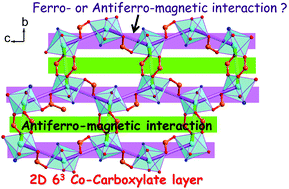Embedding 1D or 2D cobalt–carboxylate substrates in 3D coordination polymers exhibiting slow magnetic relaxation behaviors: crystal structures, high-field EPR, and magnetic studies†
Abstract
By utilizing well-designed bifunctional ligands derived from 1H-imidazole-4,5-dicarboxylic acid, magnetic coordination polymers (CPs) that exhibit slow magnetic relaxation at the low temperature regions were constructed and further structurally characterized. In 1, 1D cobalt–carboxyl chains were stabilized in the final structure. In contrast, by adjusting the length of the substituted arms on imidazole-4,5-dicarboxylic acid, a novel 3D CP, 2 containing 2D 63 cobalt–carboxyl layer was obtained. A combination of Quantum Monte Carlo (QMC) simulations and the first-principles Density functional theory (DFT) calculations showed that compound 2 features weak ferro- and antiferro-magnetic coupling mechanisms with two different super-exchange paths of −/+/− for syn–anti carboxylate bridges and −/−/− for syn–syn carboxylate bridges. Through HF-EPR measurements performed on polycrystalline samples over the frequency range of 60–260 GHz and field range of 0–12 T, the effective g-values of 1 and 2 were all larger than 2.00, and the signs of their D values were probably positive.



 Please wait while we load your content...
Please wait while we load your content...